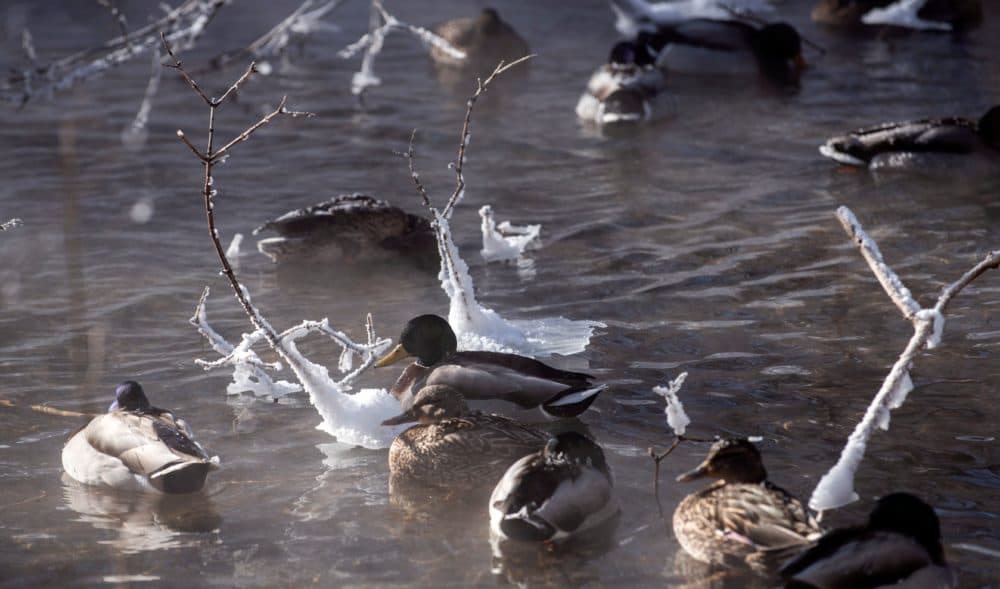Advertisement
From Frozen Frogs To Insect Antifreeze, How Animals Adapt To Bitter Cold

The bitter, life-threatening cold across parts of the country this week has created numerous challenges for people. But animals that live outside have to make major adjustments of their own to survive the subzero temperatures.
Some frogs, for example, are able to freeze themselves solid. While that might sound like giving up, biologist Bernd Heinrich says it's actually a highly specific adaptation that can mean the difference between life and death.
"It's advantageous for them to freeze, because when they're frozen, their metabolisms are very, very low, and they do not need to feed," Heinrich tells Here & Now's Peter O'Dowd. "So for example, some frogs — spring peepers and wood frogs — they can freeze solid. Frogs can't be catching flies in the wintertime, and they can't migrate."
There's also a fresh hurdle on the horizon for wildlife, with temperatures set to swing significantly upward in the Midwest and elsewhere early next week. Such rapid changes can have a "deleterious" impact on animals' ability to adapt, says Heinrich, author of "Winter World: The Ingenuity of Animal Survival."
"Some insects generate antifreeze — some insects that do not survive freezing, they have antifreeze in the blood that prevents them from being frozen," he says. "But that takes time to generate. So once these animals are thawed out, now for example, and they get rid of all of that antifreeze and then it turns cold again, then they might not have time."
Interview Highlights
On how stressful severe cold can be for animals
"There are very many different solutions that animals have, and in some cases, they survive very well, because they have evolved to handle the situation. But when it gets to unusual conditions, then at least some of the animals will have problems. The problem will depend on what their specific adaptation is. I mean, some can stand very low temperatures, because they freeze solid and even survive that. So you have an amazing number of different adaptations to handle the cold."
"You take a little bird that weighs 6 or 7 grams, and it would, in the air, just instantly drop cold. But of course, they have insulation with feathers, and they can fluff the feathers out to have a larger layer of insulation, which helps a lot."
Bernd Heinrich
On which animals are most vulnerable when temperatures plummet
"It all depends on where they are. I mean, if you are under the snow, the temperatures that they experience are not very low at all. I mean they're near the freezing point. For example, I was just digging in the snow here to put insulating snow around the house and the cabin, and I saw all kinds of tunnels down there. If air temperatures get to minus 40, those mice and shrews down there under the snow, they're probably going to be quite well. On the other hand, if it's the birds up above the snow, they have a very different problem.
"One of the main problems that birds face is finding enough food to generate the heat to keep warm, because they cannot withstand being frozen. You take a little bird that weighs 6 or 7 grams, and it would, in the air, just instantly drop cold. But of course, they have insulation with feathers, and they can fluff the feathers out to have a larger layer of insulation, which helps a lot. And shelter, I mean woodpeckers, for example, will actually hollow out tree stumps to make themselves little shelters. Other birds will actually dive into the snow, to help them save energy. Some of them lower their body temperature, like chickadees will lower themselves [to a] lower temperature, like 5 or 6 degrees. That means they're losing less heat, they have to generate less heat."
Advertisement
On climate change's long-term impact on animals' ability to adapt
"Migration patterns will change. Most animals are adapted to very specific climate — you change the climate, and boom, they're gone, if it's changed too much. So it's extremely important to have a climate that's predictable that they can plan for. I mean that metaphorically, planning for, I mean adapting to physiology and behavior. So for example, if birds migrate, they're going from a place where they might not find food in another place where they expect food, and if the climate has changed there and the insects aren't there, then they're going to be in trouble."
Jill Ryan produced this interview and edited it for broadcast with Todd Mundt. Jack Mitchell adapted it for the web.
This segment aired on February 1, 2019.
